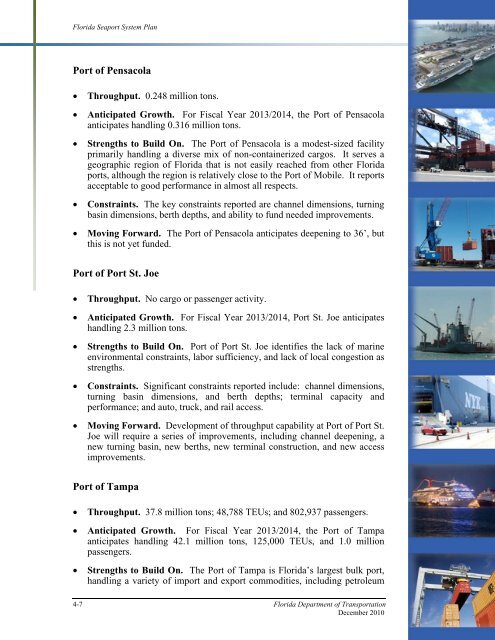Florida Seaport System Plan - SeaCIP
Florida Seaport System Plan - SeaCIP
Florida Seaport System Plan - SeaCIP
You also want an ePaper? Increase the reach of your titles
YUMPU automatically turns print PDFs into web optimized ePapers that Google loves.
<strong>Florida</strong> <strong>Seaport</strong> <strong>System</strong> <strong>Plan</strong><br />
Port of Pensacola<br />
• Throughput. 0.248 million tons.<br />
• Anticipated Growth. For Fiscal Year 2013/2014, the Port of Pensacola<br />
anticipates handling 0.316 million tons.<br />
• Strengths to Build On. The Port of Pensacola is a modest-sized facility<br />
primarily handling a diverse mix of non-containerized cargos. It serves a<br />
geographic region of <strong>Florida</strong> that is not easily reached from other <strong>Florida</strong><br />
ports, although the region is relatively close to the Port of Mobile. It reports<br />
acceptable to good performance in almost all respects.<br />
• Constraints. The key constraints reported are channel dimensions, turning<br />
basin dimensions, berth depths, and ability to fund needed improvements.<br />
• Moving Forward. The Port of Pensacola anticipates deepening to 36’, but<br />
this is not yet funded.<br />
Port of Port St. Joe<br />
• Throughput. No cargo or passenger activity.<br />
• Anticipated Growth. For Fiscal Year 2013/2014, Port St. Joe anticipates<br />
handling 2.3 million tons.<br />
• Strengths to Build On. Port of Port St. Joe identifies the lack of marine<br />
environmental constraints, labor sufficiency, and lack of local congestion as<br />
strengths.<br />
• Constraints. Significant constraints reported include: channel dimensions,<br />
turning basin dimensions, and berth depths; terminal capacity and<br />
performance; and auto, truck, and rail access.<br />
• Moving Forward. Development of throughput capability at Port of Port St.<br />
Joe will require a series of improvements, including channel deepening, a<br />
new turning basin, new berths, new terminal construction, and new access<br />
improvements.<br />
Port of Tampa<br />
• Throughput. 37.8 million tons; 48,788 TEUs; and 802,937 passengers.<br />
• Anticipated Growth. For Fiscal Year 2013/2014, the Port of Tampa<br />
anticipates handling 42.1 million tons, 125,000 TEUs, and 1.0 million<br />
passengers.<br />
• Strengths to Build On. The Port of Tampa is <strong>Florida</strong>’s largest bulk port,<br />
handling a variety of import and export commodities, including petroleum<br />
4-7 <strong>Florida</strong> Department of Transportation<br />
December 2010
















